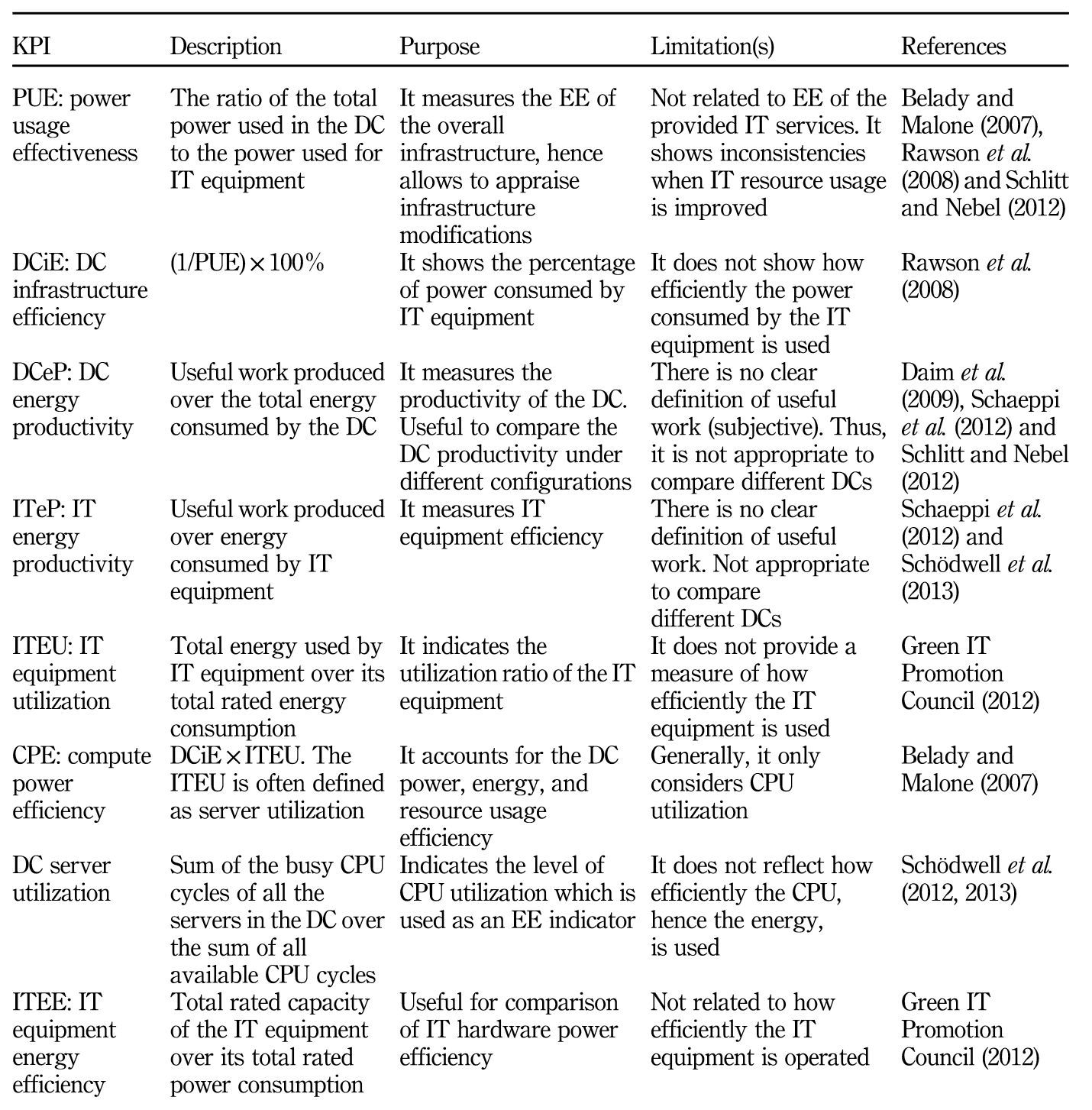EEUI: a new measure to monitor and manage energy efficiency in data centers
Status:: 🟩
Links:: Data Center Sustainability Metrics
Zotero Tags:: #zotero/✅ #zotero/💎 #zotero/data_center_efficiency
Metadata
Type:: #zotero/journalArticle
Authors:: Abaunza, Felipe; Hameri, Ari-Pekka; Niemi, Tapio
Title:: EEUI: a new measure to monitor and manage energy efficiency in data centers
Publication Title:: "International Journal of Productivity and Performance Management"
Date:: 2018
URL:: https://doi.org/10.1108/IJPPM-08-2016-0160
Bibliography
Abaunza, F., Hameri, A.-P., & Niemi, T. (2018). EEUI: A new measure to monitor and manage energy efficiency in data centers. International Journal of Productivity and Performance Management, 67(1), 111–127. https://doi.org/10.1108/IJPPM-08-2016-0160
Zotero
Abstract
Purpose Data centers (DCs) are similar to traditional factories in many aspects like response time constraints, limited capacity, and utilization levels. Several indicators have been developed to monitor and compare productivity in manufacturing. However, in DCs most used indicators focus on technical aspects of infrastructure, not efficiency of operations. The purpose of this paper is to rely on operations management to define a commensurate and proportionate DC performance indicator: the energy-efficient utilization indicator (EEUI). EEUI makes objective and comparative assessment of efficiency possible independently of the operating environment and its constraints. Design/methodology/approach The authors followed a design science approach, which follows the practitioner’s initial steps for finding solutions to business relevant problems prior to theory building. Therefore, this approach fits well with this research, as it is primarily motivated by business and management needs. EEUI combines both the amount of energy consumed by different components and their current energy efficiency (EE). It reaches its highest value when all server components are optimally loaded in EE sense. The authors tested EEUI by collecting data from three scientific DCs and performing controlled laboratory tests. Findings The results indicate that the optimization of EEUI makes it possible to run computing resources more efficiently. This leads to a higher EE and throughput of the DC while reducing the carbon footprint associated to DC operations. Both energy-related costs and the total cost of ownership are consequently reduced, since the amount of both energy and hardware resources needed decrease, while improving DC sustainability. Practical implications In comparison with current DC operations, the results imply that using the EEUI could help increase the EE of DCs. In order to optimize the proposed EEUIs, DC managers and operators should use resource management policies that increase the resource usage variation of the jobs being processed in the same computing resources (e.g. servers). Originality/value The paper provides a novel approach to monitor the EE at which computing resources are used. The proposed indicator not only considers the utilization levels at which server components are used but also takes into account their EE and energy proportionality.
Notes & Annotations
The purpose of this paper is to rely on operations management to define a commensurate and proportionate DC performance indicator: the energy-efficient utilization indicator (EEUI). EEUI makes objective and comparative assessment of efficiency possible independently of the operating environment and its constraints.
To measure resource usage efficiency and power consumption, four key concepts in computing clusters should be monitored: energy, power, throughput, and quality of service (QoS) (often response time).
For instance, idle servers consume around 30 percent of their peak power consumption (Barroso et al., 2013).
servers running at low utilization levels, around 20 percent, can consume approximately 60 percent of their peak power consumption (Barroso et al., 2013; Barroso and Hölzle, 2007, 2009).
Regarding power efficiency, Barroso and Hölzle (2007) defined it as the ratio of utilization to power consumption. Note that the previous studies assume that increasing the utilization of DC resources improves both energy and power efficiency, implying that the EE of the resources is a monotone increasing function of their utilization levels, which is not necessarily true.
the main objective of this research is to reduce the amount of resources, including energy, required to process any set of jobs, thus increasing the EE of DCs, which reduces both their energy costs and their associated carbon footprint, hence decreasing the effects of DC operations on the environment.
Among the most common power management techniques in the literature are consolidation, virtualization, dynamic voltage and frequency scaling (DVFS), and dynamic resource sleeping.
Consolidation switches hardware resources on and off according to the workload. For instance, it is possible to use a smaller number of higher utilized servers instead of a large number of low utilized servers. Virtualization facilitates consolidation by supporting multiple independent virtual machines on one physical server (Shuja et al., 2012). These two techniques are widely used to increase utilization levels and improve DC EE (Dumitru et al., 2011). Using DVFS techniques also improves EE by decreasing the operating power of servers, but it also affects performance (Kaxiras and Martonosi, 2008).

Energy efficiency measures in data centers
CPU utilization is frequently used as an indicator for server utilization (Barroso et al., 2013; Barroso and Hölzle, 2007; Wang and Khan, 2013). Therefore, the most common applied policy to increase server EE is to increase CPU utilization. Nevertheless, Piro et al. (2009) highlighted the importance of improving the overall resource utilization and not only CPU utilization.
Thus, the higher the utilization levels of the server components (hence the server throughput) the higher the server EE. This is due to the lack of energy proportionality of the server components used.
The results indicate that the optimization of EEUI makes it possible to run computing resources more efficiently. This leads to a higher EE and an increment in the total number of jobs processed per unit of time (throughput). Both energy-related costs and the total cost of ownership are therefore reduced, since the amount of both energy and hardware resources needed decrease.
As the carbon footprint is reduced due to greater EE, the negative effect on the environment and society caused by it (i.e. global warming) decreases (Barroso and Hölzle, 2009) while DC sustainability increases. Furthermore, since the system energy consumption drops, so does the heat generated by the system, therefore improving its reliability and stability (Uddin and Rahman, 2012).